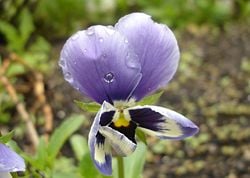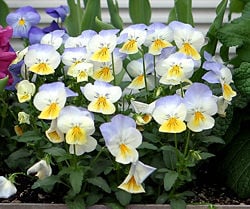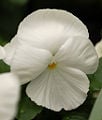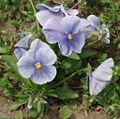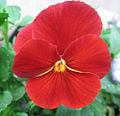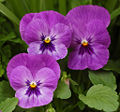Pansy
| Pansy | ||||||||||||||
|---|---|---|---|---|---|---|---|---|---|---|---|---|---|---|
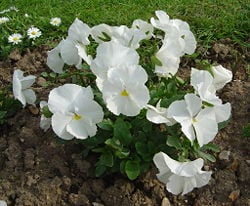 | ||||||||||||||
| Scientific classification | ||||||||||||||
| ||||||||||||||
| Viola tricolor hortensis |
The pansy or pansy violets are a large group of plants cultivated as garden flowers. Pansies are derived from Viola species Viola tricolor and they often include hybrids with other viola species, these hybrids are referred to as Viola × wittrockiana or less commonly Viola tricolor hortensis. The name "pansy" also appears as part of the common name for other Viola species that are wildflowers in Europe. Some unrelated species, such as the Pansy Monkeyflower, also have "pansy" in their name.
Cultivation, breeding and life cycle
Pansy breeding has produced a wide range of flower colors including yellow, gold, orange, purple, violet, red, white, and even black (dark purple) many with large showy face markings. A large number of bicoloured flowers have also been produced. They are generally very cold hardy plants surviving freezing even during their blooming period. Plants grow well in sunny or partially sunny positions in well draining soils. Pansies are developed from viola species that are normally biennials with a two-year life cycle. The first year plant produce greenery and then bear flowers and seeds their second year of growth and afterwards die like annuals. Because of selective human breeding, most garden pansies bloom the first year, some in as little as nine weeks after sowing.
Most biennials are purchased as packs of young plants from the garden centre and planted directly into the garden soil. Under favourable conditions, pansies and viola can often be grown as perennial plants, but are generally treated as annuals or biennial plants because after a few years of growth the stems become long and scraggly. Plants grow up to nine inches (23 cm) tall, and the flowers are two to three inches (about 6 cm) in diameter, though there are some smaller and larger flowering cultivars available too.
Pansies are winter hardy in zones 4-8. They can survive light freezes and short periods of snow cover, in areas with prolonged snow cover they survive best with a covering of a dry winter mulch. In warmer climates, zones 9-11, pansies can bloom over the winter, and are often planted in the fall. In these climates, pansies have been known to reseed themselves and come back the next year. Pansies are not very heat-tolerant; they are best used as a cool season planting, warm temperatures inhibit blooming and hot muggy air causes rot and death. In colder zones, pansies may not persist without snow cover or protection (mulch) from the extreme cold.
Pansies should be watered thoroughly about once a week, depending on climate and rainfall. To maximize blooming, plant food should be used about every other week, according to the plant food directions. Regular deadheading can extend the blooming period.
Anatomy
The pansy has two top petals overlapping slightly, two side petals, beards where the three lower petals join the center of the flower, and a single bottom petal with a slight indentation.
Diseases
{{#invoke:Message box|ambox}}
Stem rot
Stem rot, also known as pansy sickness, is a soil-borne fungus and a possible hazard with unsterilized animal manure. The plant may collapse without warning in the middle of the season. The foliage will flag and lose color. Flowers will fade and shrivel prematurely. Stem will snap at the soil line if tugged slightly. The plant is probably a total loss unless tufted. The treatment of stem rot, includes the use of fungicides such as Cheshunt or Benomyl , which are used prior to planting. Infected plants are destroyed (burned) to prevent the spread of the pathogen to other plants.
Watering
The plant should be watered every other day, and watering should never be missed for more than three days. The plant should never be over watered.
Leaf spot
Leaf spot (Ramularia deflectens) is a fungal infection. Symptoms include dark spots on leaf margins followed by a white web covering the leaves. It is associated with cool damp springs.
Mildew
Mildew (Oidium) is a fungal infection. Symptoms include violet-gray powder on fringes and underside of leaves. It is caused by stagnant air and can be limited but not necessarily eliminated by spraying (especially leaf undersides).
Cucumber mosaic virus
The cucumber mosaic virus is transmitted by aphids. Pansies with the virus have fine yellow veining on young leaves, stunted growth and anomalous flowers. The virus can lay dormant, affect the entire plant and be passed to next generations and to other species. Prevention is key: purchases should consist entirely of healthy plants, and pH-balanced soil should be used which is neither too damp nor too dry. The soil should have balanced amounts of nitrogen, phosphate and potash. Other diseases which may weaken the plant should be eliminated.
Pests
Slugs and snails
To ward off slugs and snails, sharp, gritty sand can be laid, or the soil can be top-dressed with chipped bark. The area should be kept clean of leaves and foreign matter, etc. Beer in little bowls buried to the rims in the flower beds will also keep slugs and snails at bay.
Aphids
To combat aphids, which spread the cucumber mosaic virus, the treatment is to spray with diluted soft soap (2 ounces per gallon).
Cultivars
The Universal Plus series of 21 cultivars covers all the common pansy colours except orange and black.
Name origin and significance
The name pansy is derived from the French word pensée meaning "thought", and was so named because the flower resembles a human face; in August it nods forward as if deep in thought. Because of this the pansy has long been a symbol of Freethought[1] and has been used in the literature of the American Secular Union. Humanists use it too, as the pansy's current appearance was developed from the Heartsease by two centuries of intentional crossbreeding of wild plant hybrids. The Freedom From Religion Foundation (FFRF) uses the pansy symbol extensively in its lapel pins and literature.
The word "pansy" has indicated an effeminate male since Elizabethan times and its usage as a disparaging term for a man or boy who is effeminate (as well as for an avowedly homosexual man) is still used. (There is a queercore musical band called Pansy Division, drawing on this association.) The word "ponce" (which has now come to mean a pimp) and the adjective "poncey" (effeminate) also derive from "pansy".
Pansies in the arts and culture
The pansy remains a favorite image in the arts, culture, and crafts, from needlepoint to ceramics. It is also the flower of Osaka, Japan.
- In 1827, Pierre-Joseph Redouté painted Bouquet of Pansies.
- In 1926, Georgia O'Keeffe created a famous painting of a black pansy called simply, Pansy. She followed with White Pansy in 1927.
- D. H. Lawrence wrote a book of poetry entitled Pansies: Poems by D. H. Lawrence.
- In William Shakespeare's play A Midsummer Night's Dream, the juice of a pansy blossom ("before, milk-white, now purple with love's wound, and maidens call it love-in-idleness") is a love potion: "the juice of it, on sleeping eyelids laid, will make a man or woman madly dote (fall in love) upon the next live creature that it sees." (Act II, Scene I see also: Oberon at II, i). Since the cultivated pansy had not yet been developed, "pansy" here means the wild Heartsease, and the idea of using it as a love potion was no doubt suggested by that name. The folkloric language of flowers is more traditional than scientific, with conventional interpretations, similar to the clichés about animals such as the "clever fox" or "wise owl". Ophelia's oft-quoted line, "There's pansies, that's for thoughts", in Hamlet (Act IV, Scene V) comes from this tradition: if a maiden found a honeyflower and a pansy left for her by an admirer, it would mean "I am thinking of our forbidden love" in symbol rather than in writing.
- The Pansy is a symbol of the Kappa Alpha Theta women's fraternity
- The Pansy is also a symbol of the Delta Delta Delta women's fraternity, and represents the alumni members.
External links
- Salazar, E. Pansy flowers. PansyFlowers.com.
- Iannotti, M. Pansies: Growing a cool weather favorite.
ReferencesISBN links support NWE through referral fees
- ↑ Gaylor, Annie Laurie (June/July 1997). Rediscovering A Forgotten Symbol Of Freethought - A Pansy For Your Thoughts. Freethought Today.
Credits
New World Encyclopedia writers and editors rewrote and completed the Wikipedia article in accordance with New World Encyclopedia standards. This article abides by terms of the Creative Commons CC-by-sa 3.0 License (CC-by-sa), which may be used and disseminated with proper attribution. Credit is due under the terms of this license that can reference both the New World Encyclopedia contributors and the selfless volunteer contributors of the Wikimedia Foundation. To cite this article click here for a list of acceptable citing formats.The history of earlier contributions by wikipedians is accessible to researchers here:
The history of this article since it was imported to New World Encyclopedia:
Note: Some restrictions may apply to use of individual images which are separately licensed.
